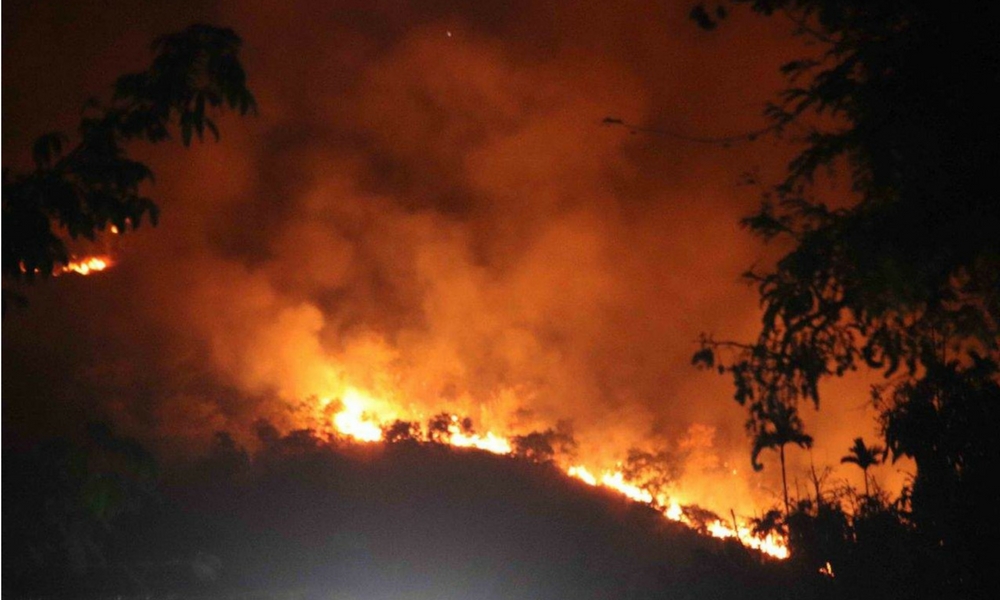In Focus
Can The Trekking Tragedy At Theni Be The Last Of Its Kind?

Jolted by the catastrophe that occurred in Theni on March 11 that has sent shockwaves across the trekking community, what is the future of forest treks in India?
Text credit: Charishma Thankappan
“Fire on the mountain; Run! Run! Run!” A childhood game was brought back to the minds of people; however, in a painfully realistic form. It was a pleasure trip to get close to Mother Nature. Comprising the young and the old, it was meant to be a brief getaway from the bustle of city life to walk through some of the most beautiful ranges of the exquisite Western Ghats. But little did anyone know that the journey back would end in the mouth of hell, literally.
A group of 39, including children, women, and men set off from Chennai on March 10 for a trekking expedition from Kurangani to Kolukkumalai hills. As per the latest reports, 11 people have died, 27 are injured in various degrees, while three returned safe as they exited the trek in its early stages. After staying overnight in Kolukkumalai, during the return journey on March 11, the group split up, losing their way, and were engulfed by the flames of a forest fire that raged their way in the Kolikkumalai area. While rescue processes have concluded, several questions are being raised about the cause and handling of the tragedy.
While blame games are flying thick and fast between the Forest department which is backed by the Tamil Nadu government, and CTC; a thought needs to be given to the actual victims and the whole community of pure trekkers, who are dependent upon the organisers to indulge in the activity. Afterall, what is pursued for thrill and adventure cannot be undertaken at the cost of life.
What happened at Theni cannot be repeated and it is the responsibility of the organisers to be fully equipped for any adverse situations. Who is responsible is indeed a question that has to be answered; however, what is more important is to ensure that such a situation never recurs and if it does, necessary measures are in place to mitigate the consequences. Who is responsible for a mishap? Every party involved in it is equally responsible – the authorities , the organisers, and trekkers.
The concept of travel varies with individuals; while some enjoy a lazy afternoon dip in a rooftop pool, others enjoy trekking up a steep terrain carrying a 10kg backpack. ‘Why’ is not important, but how it should be facilitated is what is the primary question that needs to be answered.

The breathtaking view from Kolukkumalai
Source: navrangindia
Kerala Tourism Department Corporation (KTDC) has taken all necessary steps to cater to the affluent tourists but what about the nature-enthusiasts or trekkers? Probably this lack of regulation is what resulted in the creeping up of incompetent, unqualified individuals or groups into organising treks in nature by blinding the responsible forest officials with a few currency notes.
KTDC has to work with forest departments into identifying trek routes, marking them in a non-invasive manner and regulate and monitor the usage of such treks. Regulation does not mean monetising it but being knowledgeable in the aspects that are to be fulfilled to ensure safety in adventure and being accountable for actions.
Says Arjun Majumdar, founder of IndiaHikes, the largest trekking community in India, “I see this as a freak accident and not something that we are likely to see happening more often, even if trekking grows. To our mind, the forest department must be more careful about alerting people about possible fires. I don’t think a blanket ban on trekking is advisable. These early summer months are some of the best months for trekking. However, with advance notice they can put a stop to trekking for a weekend or two or when a fire is likely to grow. From the organiser’s side, training on fire management is something every leader must know. Forest fires are rare, but fires at the camp do happen, for example, a kitchen tent catching fire. So such training is imperative for every trek leader.”
Seasoned trekker Toms Varghese echoes the sentiments of the trekking community, “The people who organised this trip cannot shirk the responsibility of this tragedy; neither can the authorities who keep trying to put the blame solely on the organisers as the forest department is well aware of the risks involved. This tragedy should lead to an in-depth inquiry into the reasons behind the wildfires as it not only poses danger to human and animal life but to an entire ecosystem that took centuries to develop.”
Here is a critical checklist that all concerned parties need to be aware of during a trek:
- Trek routes should be identified and marked in a manner which is non-invasive to nature but fulfils the purpose of finding the way
- A grading system for identified treks should be prepared based on which all identified routes will be graded
- Comprehensive information about the trek route i.e. route map, terrain, grade, best season, banned season, charges, must-carry items, number of trekkers, should be made available on the public domain
- Some form of a registration mechanism for organisers should be employed with marginal fee on the basis of criteria that need to be fulfilled in order to be eligible to be a trek organiser
- Identify and list out criteria that have to be fulfilled by organisers and trekkers before the commencement of trek
- A safety training talk should be conducted before the start of the trek. All information regarding contact personnel should be relayed to maintain communication at all times.
For organisers
- Should include one leader for every ten participants, certified first-aider, trained in emergency rescue procedures and knowledge about whom to contact and when to contact
- Should have necessary equipment that is required as a minimum to mitigate or cancel risk
- Should be knowledgeable about the treks conducted with records of pilot test treks conducted in a particular route before bringing trekkers
- All necessary permits and regulations should be fulfilled and the local authority should be met in person before arranging the trek.
Trekkers
- Trekkers should always be prepared and should know what to expect in every stage of a trek
- A trekker is the most responsible person for herself/himself so they should be aware of everything pertaining to the activity they are embarking upon.
The bottom line is that every party involved should be well aware of the hazards and consequences present in the pertinent activity and should be knowledgable to curtail such risks by early identification and also be capable of mitigating the consequences in the occurrence of a calamity.
As the nation mourns the loss of innocent souls lost to what was meant to be a thrilling memory, let us vouch to bring back the fresh grass over the path that was filled with charred bodies and make it a distant memory relegated to a fateful history.
Cover Story
Unraveling the Mystique: Leap Day Myths from Around the Globe

Leap day, that enigmatic extra day added to our calendars every four years, has long been shrouded in mystery and folklore. Across cultures and continents, various myths and beliefs have emerged surrounding this rare occurrence. Let’s embark on a journey to explore some of the fascinating leap day myths from around the world.
The Irish Tradition of Women Proposing:

One of the most well-known leap day traditions originates from Ireland. According to Irish folklore, St. Bridget struck a deal with St. Patrick, allowing women to propose to men every leap day. It was believed that this reversal of traditional gender roles would bring good luck and fortune to the couple. While this custom may seem antiquated in modern times, it serves as a reminder of the evolving nature of societal norms and the persistence of age-old customs.
Greek Superstitions:

In Greece, leap years are often associated with superstitions and caution. It is believed that any actions taken during a leap year, especially major decisions like marriage or starting a business, may be fraught with misfortune. Consequently, many Greeks prefer to postpone significant endeavors until the following year, avoiding the perceived risks associated with leap years. This superstition highlights the deeply ingrained cultural beliefs surrounding auspicious timing and the fear of tempting fate.
Leap Day Babies:

For individuals born on February 29th, known as leap day babies or leaplings, their birthdays hold a special significance that transcends conventional calendar dates. In various cultures, leap day babies are said to possess unique qualities or destinies. Some believe they are endowed with good luck, while others consider them to be blessed with eternal youth. Regardless of the superstitions, leap day babies serve as a reminder of the extraordinary nature of time and the quirks of our calendar system.
The Perplexing Aztec Calendar:

Among the ancient civilizations of Mesoamerica, such as the Aztecs, leap years held particular significance within their complex calendrical systems. The Aztec calendar, known as the Xiuhpohualli, consisted of 365 days divided into 18 months, with an additional five “nameless” days at the end of the year. To reconcile the solar year with their calendar, the Aztecs periodically inserted leap days, known as Nemontemi, to ensure alignment with the agricultural and celestial cycles. These leap days were associated with rituals and ceremonies, underscoring the interconnectedness of time, culture, and cosmology.
Lunar Leap Day in China:

In traditional Chinese culture, leap years are intricately linked to the lunar calendar and the celebration of the Chinese New Year. Known as a “leap lunar month,” this phenomenon occurs approximately every three years within the Chinese calendar cycle. During a leap lunar month, an extra lunar month is added to maintain synchronization with the solar year. This adjustment ensures that traditional festivities, such as the Lunar New Year, occur at the appropriate seasonal intervals, preserving centuries-old customs and cultural heritage.
Leap day serves as a captivating intersection of timekeeping, tradition, and folklore, weaving a tapestry of myths and beliefs from diverse cultures around the world. Whether it’s the Irish tradition of women proposing, Greek superstitions, the enigmatic Aztec calendar, or the intricacies of the Chinese lunar cycle, leap day continues to captivate our imagination and inspire wonder. As we embrace the fleeting nature of this extra day, let us reflect on the rich tapestry of human ingenuity and the enduring legacy of our collective beliefs and customs.
Beauty
Jennifer Lopez’s Daring Fashion Choice: A Wetsuit-Inspired Gown Steals the Spotlight on the Red Carpet

When it comes to making a statement on the red carpet, Jennifer Lopez is no stranger to turning heads. The multi-talented star recently attended the premiere of “The Flash” to support her husband, Ben Affleck, who reprises his role as Batman. While their public display of affection grabbed attention, it was their coordinated and eye-catching outfits that truly stole the show. Lending her style expertise, J Lo stepped out in a bold and unconventional gown inspired by wetsuit designs, proving that she continues to push the boundaries of fashion.

Styled by the talented duo Rob Zangardi and Mariel Haen, her gown was a striking creation from Gucci’s resort 2023 collection, fresh off the runways of Seoul. The ensemble featured a sleek black zip-up bodice reminiscent of scuba suits, adding a unique and unexpected element to the traditional red carpet attire. Contrasting the sporty top, a flowing peach satin maxi skirt with a long train exuded elegance and femininity.
While the gown was originally presented on the runway with a fully zipped-up collar, J Lo made a daring choice to unzip hers just above the belly button. This modification transformed the look into a more revealing and sensual ensemble, showcasing the star’s confidence and willingness to embrace risks. With every step, the gown accentuated her enviable figure, commanding attention and setting a new standard for red carpet fashion.

To complete her show-stopping look, Jennifer Lopez made careful choices when it came to accessories. She opted for a pair of white leather platform pumps from Gucci, elevating her height and adding a touch of sophistication. The choice of accessories further emphasized the fusion of sporty and elegant elements in her outfit. Complementing the gown’s black bodice, she adorned herself with exquisite jewelry pieces from Daniela Villegas and Le Vian, adding a touch of luxury and sparkle. Carrying a sleek black leather clutch bag by Kurt Geiger, J Lo effortlessly showcased her ability to curate every aspect of her ensemble.
One cannot overlook the sartorial synchrony between Jennifer Lopez and her husband, Ben Affleck. Affleck, known for his impeccable red carpet style, consistently mirrors the overall vibe of J Lo’s look. For the premiere, he opted for an all-black ensemble, comprising a sleek black suit, a matching black shirt, and polished black leather dress shoes. The couple’s synchronized fashion choices not only showcase their undeniable chemistry but also demonstrate their commitment to presenting a cohesive and visually appealing appearance together.
Jennifer Lopez continues to push fashion boundaries and surprise the world with her red carpet choices. Her wetsuit-inspired gown at “The Flash” premiere exemplifies her fearless approach to style. By incorporating sporty elements into a sophisticated ensemble, she proves that fashion can be both daring and elegant. Alongside her partner Ben Affleck, the power couple’s synchronized looks create an awe-inspiring visual spectacle, solidifying their status as fashion icons. J Lo’s ability to effortlessly command attention and make fashion statements ensures that she remains an influential force in the world of celebrity style.
Fashion
Unveiling the Mystery : The Rise of ‘Quiet Luxury’ – The Viral and Ultra-Expensive Fashion Trend Followed by Billionaires

In the world of fashion, where flamboyance and opulence often take center stage, a new trend has quietly emerged, captivating the attention of celebrities, billionaires, and fashion enthusiasts alike. Known as “Quiet Luxury,” this viral and ultra-expensive fashion trend is causing waves in the industry, challenging the conventional notions of wealth display and style.
While many high-end luxury brands are known for their ostentatious and eye-catching designs, ‘Quiet Luxury’ takes a different approach. It revolves around the concept of dressing in understated, label-less clothing that exudes an aura of sophistication and exclusivity, despite its seemingly ordinary appearance. This trend has gained significant traction over the past few months, with influential figures embracing its allure.
So, what exactly is ‘Quiet Luxury’? At its core, it is a form of subtle wealth display, where the wealthiest individuals meticulously curate their attire with understated tones, simple cuts, and an absence of prominent logos. These seemingly unassuming garments, however, come with exorbitant price tags, often costing a small fortune.

One notable incident that brought ‘Quiet Luxury’ into the spotlight was Gwyneth Paltrow’s appearance in court, clad in an impeccably tailored but discreet pantsuit. This choice perfectly exemplified the essence of ‘Quiet Luxury,’ showcasing the ability to convey elegance and affluence without resorting to overt displays of wealth.
The appeal of ‘Quiet Luxury’ lies in its ability to provide billionaires with a paradoxical blend of ordinariness and exclusivity. By adorning themselves in seemingly commonplace clothing, these individuals are able to blend in with the masses while exuding an air of refinement and extravagance. The garments they choose may appear unassuming to the untrained eye, but their true worth is hidden in the finest craftsmanship, luxurious materials, and meticulous attention to detail.
One prime example of this trend can be found in the wardrobe of Facebook founder Mark Zuckerberg, often seen sporting plain white or grey t-shirts that carry a hefty price tag. Such minimalistic pieces become the epitome of ‘Quiet Luxury,’ encapsulating the allure of hidden opulence within simplicity.
While ‘Quiet Luxury’ is not an entirely novel concept, its popularity has surged in recent times. The trend offers a safe and non-risky approach to fashion, favoring monochrome palettes, classic cuts, and timeless styles that are unlikely to fade away. This makes ‘Quiet Luxury’ an attractive option for those who seek to present themselves as both presentable and affluent, while also ensuring their fashion choices remain perpetually relevant.

In an era where ostentatious displays of wealth often dominate the fashion landscape, ‘Quiet Luxury’ stands as a captivating alternative, enticing the ultra-rich with its subtle allure. By embracing this trend, billionaires and celebrities alike have found a way to project their affluence with grace and sophistication, making a powerful statement without uttering a word.
As the influence of ‘Quiet Luxury’ continues to grow, we can only speculate on how this trend will shape the fashion industry in the coming years. Perhaps it will inspire a broader shift towards understated elegance and timeless style, encouraging individuals to redefine what it truly means to be fashionably wealthy.
-

 Style11 months ago
Style11 months agoBridal Guide : Best Looks of Radhika Merchant Ambani
-

 Entertainment1 year ago
Entertainment1 year agoThe Stunning looks from Bhagya Suresh’s Wedding
-

 Fashion1 year ago
Fashion1 year agoMost Discussed Ajrakh Saree of Alia Bhatt
-

 Entertainment1 year ago
Entertainment1 year agoThe Most Stylish Guests of Bhagya Suresh Reception
-

 Entertainment1 year ago
Entertainment1 year agoBridal Bliss : All Bridal Looks of Swasika Vijay
-

 Movies1 year ago
Movies1 year agoA Nostalgic Journey Through Love &Cinema : Best Bollywood Romantic 90s Movies
-

 AD8 months ago
AD8 months agoPopular Curtain Fabrics to Consider for Your Home
-

 Fashion1 year ago
Fashion1 year agoMajor Denim Trends You Need To Know in 2024





























